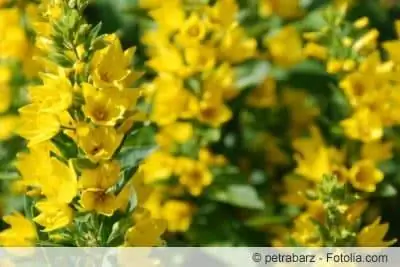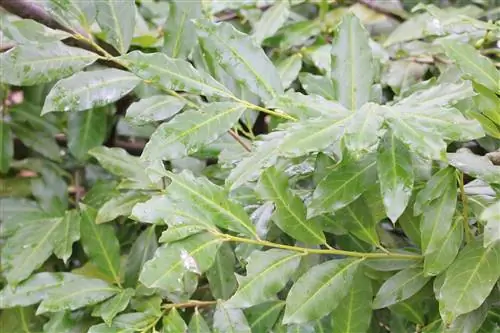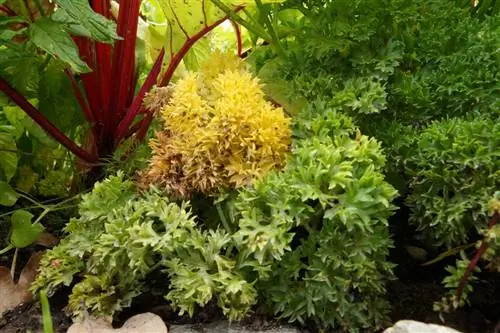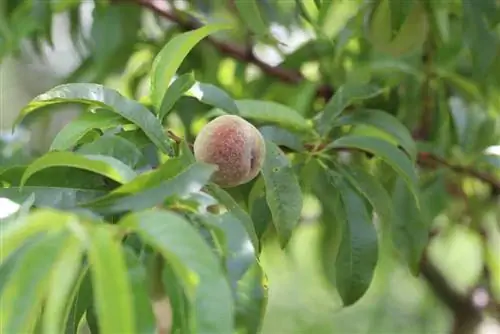- Author admin [email protected].
- Public 2024-01-17 10:10.
- Last modified 2025-01-24 12:45.
The stems of the Felbrich, which are covered with yellow flowers, can grow up to one meter high. The perennials are hardy and therefore suitable for any sunny corner, for example to hide an unsightly outside wall. However, great importance must be placed on care for the goldfelberich, as wild plants spread unhindered and could over time displace other plants cultivated in the garden. Otherwise, the hardy perennial does not require any further special care and delights with its abundant blooms in summer.
Location
The ideal location for the Felbrich is sunny and moist. If it is in light shade, this can affect its ability to bloom. Places next to water, such as a rain barrel or a garden pond, are particularly suitable. Since the goldfelberich grows up to one meter high and likes to spread, care should be taken to ensure there is enough distance from other plants, especially when planting. If the space for the Felbrich is limited, then the surrounding plants should be protected with a rhizome barrier.
Tip:
Rhizome barriers are available from specialist retailers and must be inserted into the soil before planting. This means that the roots cannot spread unhindered underground.
Substrate & Soil
The loosestrife prefers a humus-rich, loamy, nutrient-rich, moist and water-retaining soil. This can be offered to him as follows:
- Mixture of fresh garden soil, compost and some clay is ideal
- Mix in bark mulch so the soil stays moist longer
- Bark mulch on the soil around the plant prevents the water from evaporating quickly
Watering & Fertilizing

Since the goldfelberich prefers moist soil, it needs to be watered more often. The plant does not easily tolerate a longer dry period, but waterlogging should also be avoided. Low-lime and soft water is suitable for watering, so the rainwater collected from the bin is ideally used. If there is a longer period of rain, the Felbrich does not need to be watered. During long dry periods, however, the plant can also be sprayed from above. Fertilizing the plant can usually be avoided. However, with an older plant the following should be taken into account:
- the flowering power of the Felbrich can decrease with age
- In such a case, work compost or bark mulch back into the soil
- Plant can also be planted in a new location with fresh substrate
- these measures only need to be taken every two to three years
- once a year the Felbrich can also be watered with nettle manure for fertilization
Tip:
When spraying the plant with water, make sure to use the evening hours so that the sun cannot burn the leaves and flowers. Otherwise, the water drops remaining on it act like a magnifying glass.
Plants
The ideal time to plant the Felbrich is spring or autumn, although it should be ensured that this is the frost-free period so that the plant can grow well. When digging the hole, measure the root beforehand as the hole should only be slightly deeper than the longest root. Pay attention to the following when planting:
- mix excavated soil with clay, compost and bark mulch
- use a wheelbarrow provided for this
- Insert goldfelberich and fill with the prepared soil
- water thoroughly for the next two to three weeks
Tip:
If the Felbrich was planted in autumn, water it until the first frost sets in.
Cultivate loosestrife in a bucket
So that the Felbrich cannot spread throughout the garden, it can also be cultivated in a bucket. In this case it needs to be watered more frequently because the soil in the bucket dries out more quickly. In winter, despite the plant's hardiness, the bucket should be wrapped with garden fleece to protect it from frost. Fertilization with compost and bark mulch is also desirable for container cultivation every year.
Cutting
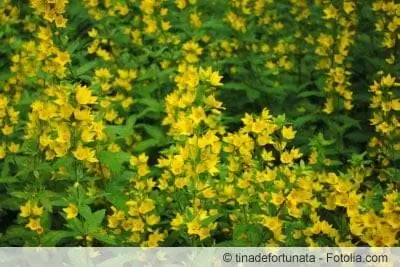
Pruning is particularly important when caring for loosestrife so that it doesn't become too overgrown. However, this is not a topiary but rather a radical annual pruning. This is done in autumn when the Felbrich has finished flowering. This cut serves to improve the appearance and also to keep the plant he althy. A topiary can be omitted because the plant grows bushy and dense. Therefore, the pruning in autumn should be done as follows:
- cut back radically to a hand's breadth above the ground
- If the cut was missed in the fall, it can also be done in the spring before the new shoots
- However, a cut plant survives a harsh, frosty winter better
Tip:
In summer, individual flowering stems can be used for the vase. The Felbrich looks particularly beautiful in a bouquet of meadow flowers.
Propagate
The slightly overgrown Felbrich spreads all by itself in its location. But if propagation is to be done so that another location in the garden can be planted with the perennial, then this is done by root division. To do this, proceed as follows:
- Dig up the plant or expose the roots
- cut the root vertically in the middle with a sharp, disinfected knife
- If you can already see runner roots on the main root, use them for propagation and cut them off
- let the interface dry for a few hours
- replant the new plant in the new, prepared location
- Propagation by division ideally takes place in spring or autumn
Repotting or moving
As an alternative to propagation by root division, the entire plant can also be moved to a larger pot with fresh soil or to another location in the garden, also with newly prepared fresh soil. If you still want to propagate, you can do this in the same step, as the roots are also exposed.
Felbrich Overwintering
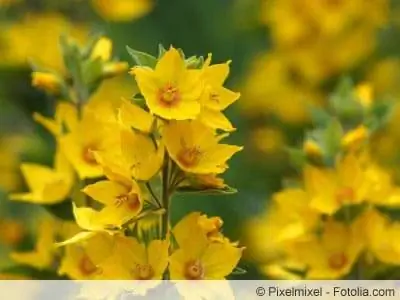
The Felbrich is hardy and therefore does not need to be protected even in frost. However, care should be taken to ensure that watering is virtually stopped below a temperature of 8° Celsius. During this time, only water the plant if the soil is very dry. On frosty days the goldfelberich may no longer be watered.
Care errors, diseases or pests
Drought or root rot are care errors that can definitely be avoided, as is poor growth due to a location that is too dark. Commercially available products help against pests such as snails, aphids or caterpillars.
Conclusion
The goldfellow is a beautiful, yellow-flowering plant that the hobby gardener has to invest a little more time in caring for so that it blooms in summer. The Felbrich needs to be watered frequently and cut back every year. In addition, with this beautiful garden plant, care must be taken to ensure that it does not spread unhindered and crowd out other plants cultivated in the garden. However, if the hobby gardener follows all the care instructions, he can enjoy the splendor of the flowers every summer.

